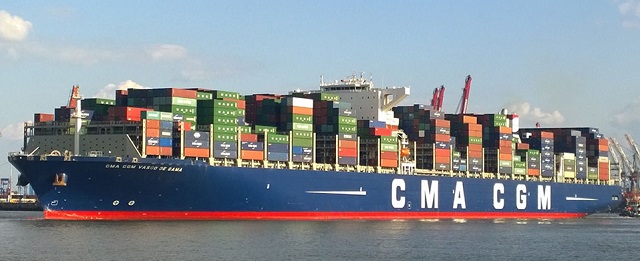Overconfidence Contributed to Mega-Ship Grounding
The U.K. Marine Accident Investigation Branch (MAIB) has released its report on the grounding of the ultra-large container vessel CMA CGM Vasco de Gama, citing that onboard navigation standards did not meet the expectations of the port involved.
“It was apparent that complacency and a degree of overconfidence on the part of the master and port pilots contributed to this accident,” states the report. “However, it was also apparent from recent similar incidents and the findings of previous MAIB reports that many of the practices evident in this case were not specific to this single pilotage act or to CMA CGM Vasco de Gama.”
MAIB has embarked on a study into the human factors associated with the use of modern electronic navigation aids and the implementation of mandated navigation standards.
 The Incident
The Incident
In the early hours of the morning on August 22, 2016, the 399-meter (1,309-foot) CMA CGM Vasco de Gama grounded on the western side of the Thorn Channel whilst approaching the Port of Southampton. The ship ran aground on a rising tide and on a flat shingle/sand sea-bed. A combination of tugs and ship’s engines enabled it to be re-floated soon after grounding.
The grounding occurred because the vessel was too far north of the intended track when the turn into the Thorn Channel was commenced. This reduced the sea room available for the maneuver and, given the environmental conditions, CMA CGM Vasco de Gama was unable to sustain the rate of turn required to remain in the dredged channel. The execution of the vessel’s turn by the lead pilot was not in accordance with the port’s guidance for large inbound vessels.
The vessel was the largest U.K.-flagged vessel at the time and had two of the port’s specialist container ship pilots on board. The investigation found that the vessel’s bridge team and the port’s pilots had the experience, knowledge and resources available to plan and execute the passage effectively. However, the standards of navigation, communication and effective use of the electronic charting aids on board did not meet the expectations of the port or the company.
A detailed plan had not been produced; the lead pilot had not briefed his plan for the turn round Bramble Bank; the bridge team’s roles and responsibilities were unclear. There was an absence of a shared understanding of the pilot’s intentions for passing other vessels or for making the critical turns during the passage.
Neither the ship’s ECDIS nor the pilot’s Portable Pilot Unit functionality were fully utilized and resulted in each system not providing adequate cross checks or alarms.
Recommendations
The increasing size of vessels within restricted waterways, is leading to reduced margins of operational safety, and therefore the importance of proper planning and monitoring of the passage cannot be overemphasized, stated the MAIB report.
ABP Southampton has been recommended to improve bridge resource management for its pilots; to consider the provision of provisional pilotage plans to vessels prior to pilot embarkation; to review its implementation of procedures and to improve standards of communication.
CMA Ships has been recommended to review implementation of company procedures for passage planning and use of ECDIS and to include pilotage and bridge team/pilot integration in its internal audit process.
The report is available here.
